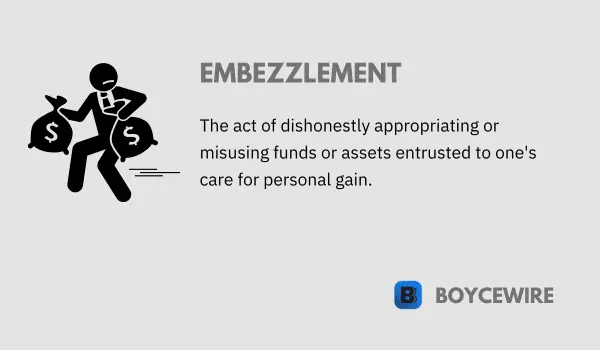Embezzlement: Definition, Signs & Effects

What is Embezzlement?
Embezzlement, a term often associated with high-profile financial scandals, represents a serious breach of trust that can have far-reaching implications for businesses and individuals alike. Despite its seeming complexity, the core concept of embezzlement is simple: it is a form of financial fraud where someone misappropriates assets entrusted to their care, typically in a business or employment context.
From large corporations to small businesses, no organization is immune to the threat of embezzlement. Regardless of its scale, it not only leads to significant financial loss but also erodes the trust that forms the bedrock of all financial transactions. In recent years, as financial systems have become increasingly complex, the importance of understanding, detecting, and preventing embezzlement has never been more crucial.
Key Points
- Embezzlement refers to the act of unlawfully misappropriating funds or assets entrusted to one’s care for personal gain.
- It typically involves individuals in positions of trust or authority who have access to funds or assets belonging to others.
- Embezzlement can be carried out through various methods, such as falsifying records, diverting funds, or manipulating financial transactions.
Understanding Embezzlement
Embezzlement is a type of financial fraud characterized by the misappropriation or misuse of funds entrusted to an individual for their care or control. This crime is typically associated with the business or corporate world, but it can occur in any situation where one party entrusts another with money or assets.
The critical factor in embezzlement is the breach of trust. The person embezzling the funds is usually in a position of responsibility or trust and has legal access to the money or assets. They then exploit this access to illicitly use the funds or assets for personal gain, betraying the trust placed in them.
Distinction from Other Types of Theft
Embezzlement differs from other types of theft like burglary or robbery. In cases of burglary or robbery, the perpetrator unlawfully takes property without the owner’s consent. In contrast, embezzlement involves a person who is lawfully entrusted with the property but uses it unlawfully.
For instance, a company’s accountant who diverts some of the company’s funds to a personal account is committing embezzlement. The accountant has legal access to the funds due to their position but uses this access illicitly for personal gain.
The Trust Factor
A defining feature of embezzlement is the violation of trust. The individual committing the crime is often in a position of trust and authority. They could be an employee, a financial advisor, an executor of a will, or a public official, among others.
This position of trust often allows the embezzler to conceal their illicit activities for a while, making embezzlement a sophisticated type of theft that can go undetected for years.
The Process of Embezzlement
Embezzlement typically involves a series of steps or actions taken by an individual to misappropriate funds or assets. While each instance can have its unique characteristics, there is usually a common pattern that can be observed.
1. Position of Trust
The first precondition is a position of trust, where an individual has legal access or control over certain funds or assets. This person could be an employee, an executive, a trustee, or any other individual in a similar position.
2. Misappropriation of Funds
Once the individual is in a position where they can access funds or assets, they then misappropriate these resources. Misappropriation refers to the unauthorized and illegal use of the resources for personal gain. This can involve diverting funds to a personal account, making unauthorized transactions, or stealing physical assets.
3. Concealment
The next step in the embezzlement process is concealment. The person committing the fraud uses their knowledge of the organization’s systems to hide their activities. This can involve manipulating financial records, creating false documents, overbilling, under-reporting income, or other forms of deceit. The embezzler’s aim is to avoid detection for as long as possible.
4. Discovery
Despite the efforts to hide the crime, embezzlement is often eventually discovered. This usually occurs when an audit is performed, when a customer or another employee notices discrepancies, or when the fraudulent activity becomes too large to conceal.
5. Legal Action and Consequences
Once the embezzlement is discovered, legal action typically follows. The consequences can include restitution (paying back the stolen amount), fines, and imprisonment.
Signs and Effects of Embezzlement
Signs of Embezzlement
- Financial discrepancies: These could include unexplained or persistent discrepancies in financial records, missing funds, or unexpected budget shortfalls.
- Excessive secrecy or possessiveness: If an employee is overly secretive about their work, unwilling to share tasks or take vacation, or reacts defensively to reasonable inquiries, it could be a warning sign.
- Lifestyle changes: A sudden and unexplained increase in an employee’s standard of living could signal embezzlement, particularly if their salary doesn’t align with their spending.
- Unusual or overly complex transactions: Embezzlers often create convoluted transactions to hide their activities. An increase in complicated transactions could signal a problem.
- Customer or vendor complaints: Frequent complaints about billing errors, missing payments, or unfulfilled orders might indicate fraudulent activity.
Detecting embezzlement can be challenging due to its covert nature. However, several potential red flags may indicate fraudulent activity. Financial discrepancies, such as unexplained or persistent discrepancies in financial records or unexpected budget shortfalls, may indicate fraudulent activity. Excessive secrecy, possessiveness, or defensiveness from an employee regarding their work can be a warning sign. Lifestyle changes, such as a significant increase in standard of living without a corresponding increase in salary, might suggest embezzlement. Unusual or overly complex transactions that are difficult to explain or understand could be a cause for concern. Additionally, frequent complaints from customers or vendors about billing errors or missing payments could point to fraudulent activity.
Effects of Embezzlement
- Financial loss: The most immediate effect of embezzlement is financial loss. Depending on the scale, this loss can significantly impact a company’s operations and future prospects.
- Reputation damage: The discovery of embezzlement can damage a company’s reputation, leading to loss of clients, difficulty in attracting new business, and potential regulatory scrutiny.
- Operational disruption: Embezzlement can disrupt operations, especially if the guilty party played a crucial role in the company or if the stolen funds were earmarked for important activities.
- Trust erosion: Embezzlement erodes trust within the company. Employees may feel betrayed and demoralized, which can impact productivity and employee morale.
The effects of embezzlement can be severe and far-reaching. The most immediate effect is the financial loss resulting from the misappropriation of funds or assets. This loss can impact the company’s operations and future prospects. Additionally, the discovery of embezzlement can damage the company’s reputation, leading to the loss of clients, difficulty in attracting new business, and potential regulatory scrutiny. The operational disruption caused by embezzlement can be significant, especially if the guilty party played a crucial role in the company or if the stolen funds were intended for important activities. Furthermore, embezzlement erodes trust within the company, creating a sense of betrayal and demoralization among employees, which can ultimately affect productivity and employee morale.
Prevention of Embezzlement
Preventing embezzlement involves implementing safeguards to deter potential fraudsters and detect irregularities early on. Here are several strategies an organization can use to reduce the risk:
1. Internal Controls:
Having robust internal controls is one of the most effective measures. This could involve segregation of duties, where no single individual has control over all parts of a financial transaction. For example, the person who makes bank deposits should not be the same person reconciling bank statements.
2. Regular Audits:
Regular financial audits, both internal and external, can help identify discrepancies and potential fraudulent activities. Surprise audits can also be particularly effective, as they do not allow a potential embezzler time to manipulate the books to hide evidence.
3. Background Checks:
Before hiring staff, especially for positions of financial responsibility, conducting a thorough background check can help identify potential red flags. This might include a history of financial difficulties, previous criminal convictions, or a record of job hopping.
4. Clear Policies and Procedures:
Having clear, written policies and procedures related to financial transactions and handling of assets can provide a guideline for acceptable behavior. It’s also essential to have a policy for reporting suspicious activities, ensuring employees know how to report and that they can do so anonymously.
5. Encourage Vacation Time:
Many cases are discovered when the person committing the fraud takes a vacation, and someone else takes over their responsibilities temporarily. Encouraging employees to take regular vacation time can potentially uncover any ongoing embezzlement.
6. Foster an Ethical Culture:
Fostering a culture of honesty and integrity can help deter potential embezzlers. This might involve clear communication about ethics policies, providing ethics training, and leading by example at the managerial and executive level.
Detection of Embezzlement
Despite the best preventive measures, embezzlement can still occur. Early detection can limit the damage and aid in the recovery of misappropriated funds or assets. Here are some strategies for detecting itm :
- Regular Financial Review and Analysis:
Routine examination of financial statements and transaction records can reveal inconsistencies or irregularities that may indicate embezzlement. This could include recurring discrepancies in the books, an unexplained decrease in profit margins, or irregular transactions.
- Use of Forensic Accounting:
Forensic accountants are professionals specialized in investigating fraud, including embezzlement. They use a variety of techniques, such as financial statement analysis, transaction tracing, and data analytics, to detect signs of embezzlement.
- Pay Attention to Employee Behavior:
As previously mentioned, changes in employee behavior can be a red flag for embezzlement. This includes employees who are living beyond their means, are overly possessive about their work, or resist financial reviews or audits.
- Implement a Whistleblower Program:
Establishing a confidential reporting mechanism (a whistleblower program) can encourage employees to report suspicious activities. Employees are often the first to notice signs of embezzlement, so it’s essential to have a safe and anonymous way for them to communicate their concerns.
- Install Surveillance Systems:
In cases where physical assets are being stolen, video surveillance systems can be an effective detection method. They can provide evidence of the theft and help identify the responsible party.
- Use Fraud Detection Software:
There are various software solutions available that use advanced analytics and artificial intelligence to detect signs of embezzlement and other forms of fraud. These systems can analyze large volumes of data and identify patterns or anomalies that may be indicative of embezzlement.
Remember, early detection of embezzlement is crucial to minimize losses and bring the responsible party to justice. Therefore, a combination of preventive and detective measures is the most effective approach to managing the risk of embezzlement.
FAQs
Embezzlement refers to the unlawful act of misappropriating funds or assets entrusted to one’s care for personal gain.
While theft involves taking someone else’s property without permission, embezzlement occurs when an individual who has lawful access to funds or assets misuses or steals them for personal use.
Embezzlement can be committed by individuals in positions of trust or authority, such as employees, managers, or financial professionals, who have access to funds or assets belonging to others.
Embezzlement can be carried out through various methods, including falsifying records, inflating expenses, diverting funds, creating fictitious transactions, or manipulating financial statements.
About Paul
Paul Boyce is an economics editor with over 10 years experience in the industry. Currently working as a consultant within the financial services sector, Paul is the CEO and chief editor of BoyceWire. He has written publications for FEE, the Mises Institute, and many others.

Further Reading
 Accrued Expenses - Accrued expenses refer to financial obligations incurred by a business for goods or services received but not yet paid for.
Accrued Expenses - Accrued expenses refer to financial obligations incurred by a business for goods or services received but not yet paid for.  Net Present Value: Definition, Formula & Example - Net Present Value (NPV) is the total value of future revenues, subtracted against any cash outflows during the same period.
Net Present Value: Definition, Formula & Example - Net Present Value (NPV) is the total value of future revenues, subtracted against any cash outflows during the same period.  Groupthink: Definition, Characteristics & Examples - Groupthink is the tendency for individuals to agree with each other in a group setting in order to conform and…
Groupthink: Definition, Characteristics & Examples - Groupthink is the tendency for individuals to agree with each other in a group setting in order to conform and… 
